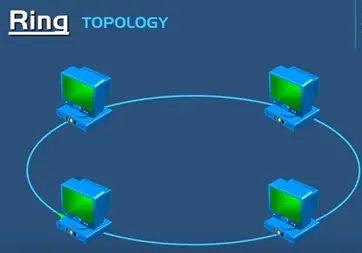NETWORK TOPOLOGIES
A topology is the layout of how a network communicates with different devices.
There are different categories of topologies are available. They are
- Wired topology
- Wireless topology
Wired topology consist of different types they are
- Star topology
- Ring topology
- Bus topology
- Mesh topology
Star topology
The most common wire topology is used star topology. In star topology all computers are connected to a central wiring point such as hub or switch. All data on a star network passes through this central point before continuing to its destination. One of the major benefits of this topology if one computer failed or there is a break in cable the other computer will not be affected because each computer has its own cable connection. However the star topology central hub or switch fails all the computers in the central point would be effected. This is called single point failure. If this happens entire network will goes down.
Ring topology
Ring topology is a type network configuration where each computer is connected to each other in the shape of closed loop or ring. So every computer on this ring has exactly two neighbor, communication purpose each stage packet is send around ring to reach its find destination. Now this type op topology is very old and rarely used. The ring topology is easy to install and easy to trouble shoot. However the disadvantage would be if one computer goes down or if a single cable break then all data flow will be disturbed.
Bus topology
The bus topology is the widely used technology not used very much.
Each computers and network devices are connected in a single cable or backbone and the backbone is the coaxial cable. The computer connects thin cable by using special connectors called BNC connector. This is also known as ‘T’ connector.
Advantage of bus topology is very cheap and simple and easy implementation.
Disadvantage the cables are terminated at both ends using terminators. In order to setup main operation it must be open connection included ends that are connected to computers.
If a computer is removed if terminations is lose or missing the cable will be open the data will bounce back. This bounce is known as signal reflection and this happens data flow will be disturbed.
Mesh topology
The mesh topology each computer on the network connected every other computer on the network so by having so many connections it handles failure very well.
The four computer and three connections will make twelve connections for this network.
Advantages
It creates a high redundancy level because one or more connection fail computer still ba able to communicate with each other because of big amount of cabling and network cards that have to be used mash topology can be expansive. They are used in local area network or LAN’s. They are mainly internet is good example for mesh topology because internet made number of routers all over the world that are connected to each other. Even if a few routers goes down the data get rerouted to different path automatically to reach destination. The internet is very redundant by using mesh topology.

Wireless topology
There are different types of wireless topology, they are
- Infrastructure wireless topology
- Adhoc topology
- Wireless mesh topology
Infrastructure wireless topology
This topology uses combination of wired and wireless devices. It is very similar to star topology you have wired devices such as computer here physically connected to a switch and also has a wireless access point that also connected by a cable through wireless devices such as laptops, tablets, cell phones etc., can connect wireless network. So wireless access point acts like a bridge between the wireless network and wired network, infrastructure topology is not limited to the single wireless access point. In-fact if you have wireless access point we can connect.
Adhoc topology
Adhoc topology is a very simple wireless topology and is simple because does not depend on any infrastructure such as cables, server, routers, WAPs points. All the devices are in Adhoc network wireless connected other devices in a simple pure to pure network directly connect to each other without using centralized devices such as a WiFi router or access point. Because they directly access without a server or router in between each devices is responsible for security and permission.
Adhoc is useful in setting quick wireless network where devices can share data with their need of wireless network.
Wireless mesh topology
Wireless mesh topology is similar wired mash topology devices are interconnected each other with the expectation that they are wireless inter connected. If we want to deploy multiple wirelesses access points in a building. The wireless devices are in different areas are able to access the internet. So normally it would have modem brings the internet to the building and also have switches that connected to the modem and you would connect each wireless point through a cable to the switch. For these connections it requires extra cables and extra time for laying cables in building.
In wireless mesh topology each wireless access point will take to other wireless access point to create seamless internet connection for wireless devices to connect once we are roaming in the building with laptop. This access point then to next one eventually finds its way to modem. In this all these access point communicating each other in the modem.
Even if one access point fail if doesn’t matter the other access point reroute the data and connect to modem. Wireless mesh topology is very redundant.
















